technical specifications FIAT FREEMONT 2013 Owner handbook (in English)
[x] Cancel search | Manufacturer: FIAT, Model Year: 2013, Model line: FREEMONT, Model: FIAT FREEMONT 2013Pages: 352, PDF Size: 5.22 MB
Page 327 of 352
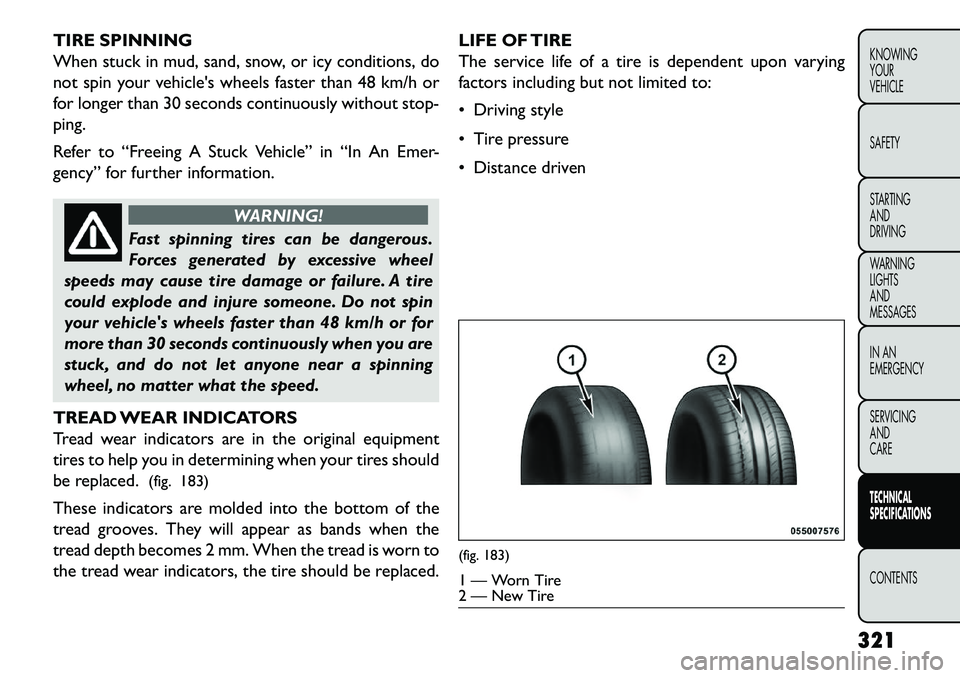
TIRE SPINNING
When stuck in mud, sand, snow, or icy conditions, do
not spin your vehicle's wheels faster than 48 km/h or
for longer than 30 seconds continuously without stop-
ping.
Refer to “Freeing A Stuck Vehicle” in “In An Emer-
gency” for further information.
WARNING!
Fast spinning tires can be dangerous.
F
orces generated by excessive wheel
speeds may cause tire damage or failure. A tire
could explode and injure someone. Do not spin
your vehicle's wheels faster than 48 km/h or for
more than 30 seconds continuously when you are
stuck, and do not let anyone near a spinning
wheel, no matter what the speed.
TREAD WEAR INDICATORS
Tread wear indicators are in the original equipment
tires to help you in determining when your tires should
be replaced. (fig. 183)
These indicators are molded into the bottom of the
tread grooves. They will appear as bands when the
tread depth becomes 2 mm. When the tread is worn to
the tread wear indicators, the tire should be replaced. LIFE OF TIRE
The service life of a tire is dependent upon varying
factors including but not limited to:
Driving style
Tire pressure
Distance driven
(fig. 183)1 — Worn Tire
2 — New Tire
321
KNOWING
YOUR
VEHICLE
SAFETY
STARTING
AND
DRIVING
WARNING
LIGHTS
AND
MESSAGES
IN AN
EMERGENCY
SERVICING
AND
CARETECHNICAL
SPECIFICATIONSCONTENTS
Page 328 of 352
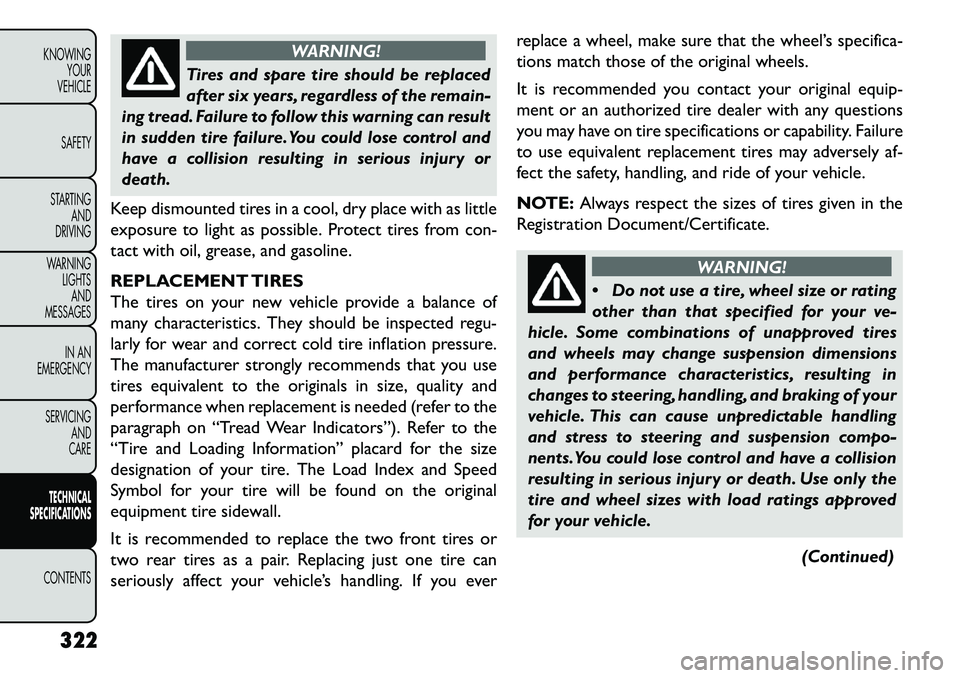
WARNING!
Tires and spare tire should be replaced
af
ter six years, regardless of the remain-
ing tread. Failure to follow this warning can result
in sudden tire failure.You could lose control and
have a collision resulting in serious injury or
death.
Keep dismounted tires in a cool, dry place with as little
exposure to light as possible. Protect tires from con-
tact with oil, grease, and gasoline.
REPLACEMENT TIRES
The tires on your new vehicle provide a balance of
many characteristics. They should be inspected regu-
larly for wear and correct cold tire inflation pressure.
The manufacturer strongly recommends that you use
tires equivalent to the originals in size, quality and
performance when replacement is needed (refer to the
paragraph on “Tread Wear Indicators”). Refer to the
“Tire and Loading Information” placard for the size
designation of your tire. The Load Index and Speed
Symbol for your tire will be found on the original
equipment tire sidewall.
It is recommended to replace the two front tires or
two rear tires as a pair. Replacing just one tire can
seriously affect your vehicle’s handling. If you ever replace a wheel, make sure that the wheel’s specifica-
tions match those of the original wheels.
It is recommended you contact your original equip-
ment or an authorized tire dealer with any questions
you may have on tire specifications or capability. Failure
to use equivalent replacement tires may adversely af-
fect the safety, handling, and ride of your vehicle.
NOTE:
Always respect the sizes of tires given in the
Registration Document/Certificate.
WARNING!
Do
not use a tire, wheel size or rating
other than that specified for your ve-
hicle. Some combinations of unapproved tires
and wheels may change suspension dimensions
and performance characteristics, resulting in
changes to steering, handling, and braking of your
vehicle. This can cause unpredictable handling
and stress to steering and suspension compo-
nents.You could lose control and have a collision
resulting in serious injury or death. Use only the
tire and wheel sizes with load ratings approved
for your vehicle.
(Continued)
322
KNOWING YOUR
VEHICLE
SAFETY
STARTING AND
DRIVING
WARNING LIGHTSAND
MESSAGES
IN AN
EMERGENCY
SERVICING AND
CARETECHNICAL
SPECIFICATIONSCONTENTS
Page 329 of 352
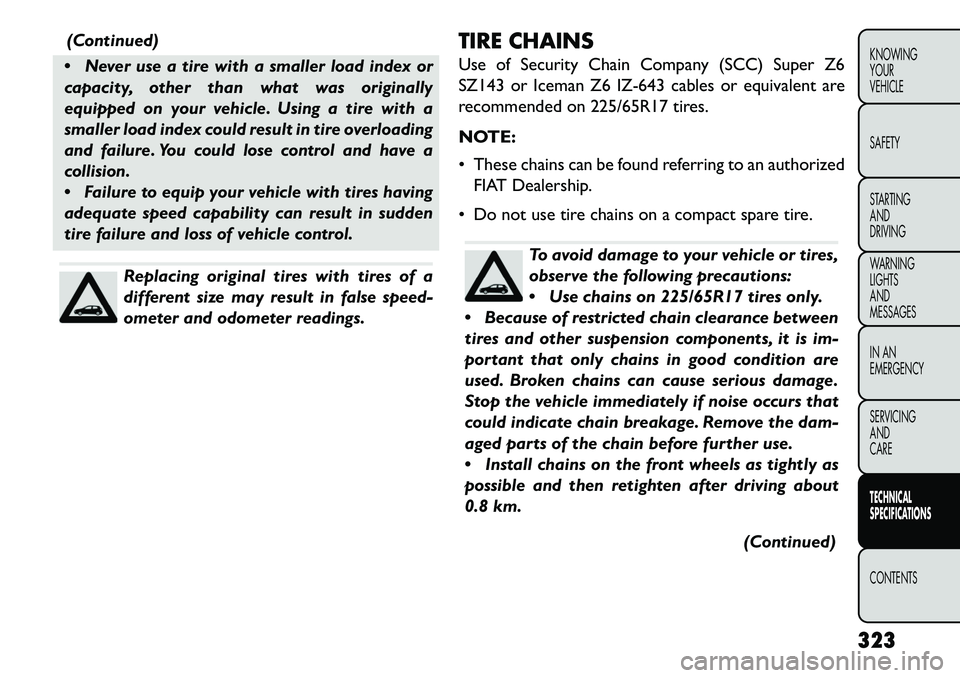
(Continued)
Never use a tire with a smaller load index or
capacity, other than what was originally
equipped on your vehicle. Using a tire with a
smaller load index could result in tire overloading
and failure. You could lose control and have a
collision.
Failure to equip your vehicle with tires having
adequate speed capability can result in sudden
tire failure and loss of vehicle control.
Replacing original tires with tires of a
different size may result in false speed-
ometer and odometer readings. TIRE CHAINS
Use of Security Chain Company (SCC) Super Z6
SZ143 or Iceman Z6 IZ-643 cables or equivalent are
recommended on 225/65R17 tires.
NOTE:
These chains can be found referring to an authorized
FIAT Dealership.
Do not use tire chains on a compact spare tire.
To avoid damage to your vehicle or tires,
observe the following precautions:
Use chains on 225/65R17 tires only.
Because of restricted chain clearance between
tires and other suspension components, it is im-
portant that only chains in good condition are
used. Broken chains can cause serious damage.
Stop the vehicle immediately if noise occurs that
could indicate chain breakage. Remove the dam-
aged parts of the chain before further use.
Install chains on the front wheels as tightly as
possible and then retighten after driving about
0.8 km.
(Continued)
323
KNOWING
YOUR
VEHICLE
SAFETY
STARTING
AND
DRIVING
WARNING
LIGHTS
AND
MESSAGES
IN AN
EMERGENCY
SERVICING
AND
CARETECHNICAL
SPECIFICATIONSCONTENTS
Page 330 of 352

(Continued)
Do not exceed 48 km/h.
Drive cautiously and avoid severe turns and
large bumps, especially with a loaded vehicle.
Do not drive for prolonged periods of time on
dry pavement .
Observe the tire chain manufacturer's instruc-
tions on the method of installation, operating
speed, and conditions for use. Always use the
lower suggested operating speed of the chain
manufacturer, if different from the speed recom-
mended by the vehicle manufacturer.
NOTE: In order to avoid damage to tires, chains, and
your vehicle do not drive for a prolonged period on dry
pavement. Observe the tire chain manufacturer's in-
structions on method of installation, operating speed,
and conditions for usage.
Always use the lower suggested operating speed if both
the chain manufacturer and vehicle manufacturer sug-
gest a maximum speed. This notice applies to all chain
traction devices, including link and cable (radial) chains. FUEL REQUIREMENTS — GASOLINE
ENGINE
All engines are designed to meet all emissions regula-
tions and provide excellent fuel economy and perfor-
mance when using high quality unleaded gasoline with a
minimum research octane rating of 91. The use of
premium gasoline is not recommended, as it will not
provide any benefit over regular gasoline in these en-
gines.
Light spark knock at low engine speeds is not harmful
to your engine. However, continued heavy spark knock
at high speeds can cause damage and immediate service
is required. Poor quality gasoline can cause problems
such as hard starting, stalling, and hesitations. If you
experience these symptoms, try another brand of
gasoline before considering service for the vehicle.
Over 40 auto manufacturer's world wide have issued
and endorsed consistent gasoline specifications (the
Worldwide Fuel Charter, WWFC) which define fuel
properties necessary to deliver enhanced emissions,
performance, and durability for your vehicle. The
manufacturer recommends the use of gasoline that
meets the WWFC specifications if they are available.
Methanol
(Methyl or Wood Alcohol) is used in a variety of
concentrations when blended with unleaded gasoline.
324
KNOWING YOUR
VEHICLE
SAFETY
STARTING AND
DRIVING
WARNING LIGHTSAND
MESSAGES
IN AN
EMERGENCY
SERVICING AND
CARETECHNICAL
SPECIFICATIONSCONTENTS
Page 331 of 352
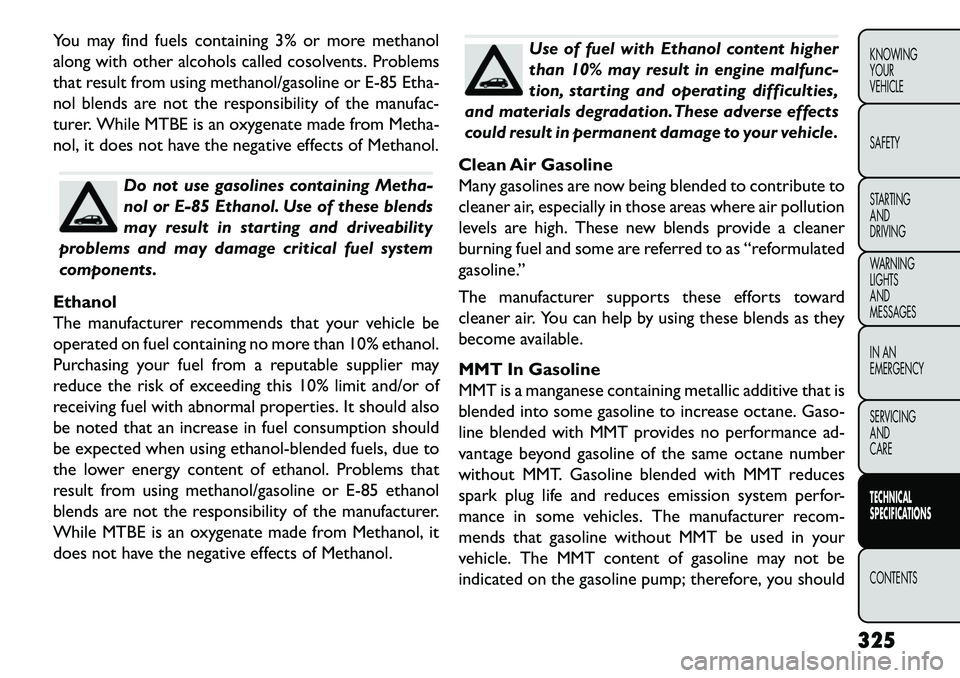
You may find fuels containing 3% or more methanol
along with other alcohols called cosolvents. Problems
that result from using methanol/gasoline or E-85 Etha-
nol blends are not the responsibility of the manufac-
turer. While MTBE is an oxygenate made from Metha-
nol, it does not have the negative effects of Methanol.
Do not use gasolines containing Metha-
nol or E-85 Ethanol. Use of these blends
may result in starting and driveability
problems and may damage critical fuel system
components.
Ethanol
The manufacturer recommends that your vehicle be
operated on fuel containing no more than 10% ethanol.
Purchasing your fuel from a reputable supplier may
reduce the risk of exceeding this 10% limit and/or of
receiving fuel with abnormal properties. It should also
be noted that an increase in fuel consumption should
be expected when using ethanol-blended fuels, due to
the lower energy content of ethanol. Problems that
result from using methanol/gasoline or E-85 ethanol
blends are not the responsibility of the manufacturer.
While MTBE is an oxygenate made from Methanol, it
does not have the negative effects of Methanol.
Use of fuel with Ethanol content higher
than 10% may result in engine malfunc-
tion, starting and operating difficulties,
and materials degradation.These adverse effects
could result in permanent damage to your vehicle.
Clean Air Gasoline
Many gasolines are now being blended to contribute to
cleaner air, especially in those areas where air pollution
levels are high. These new blends provide a cleaner
burning fuel and some are referred to as “reformulated
gasoline.”
The manufacturer supports these efforts toward
cleaner air. You can help by using these blends as they
become available.
MMT In Gasoline
MMT is a manganese containing metallic additive that is
blended into some gasoline to increase octane. Gaso-
line blended with MMT provides no performance ad-
vantage beyond gasoline of the same octane number
without MMT. Gasoline blended with MMT reduces
spark plug life and reduces emission system perfor-
mance in some vehicles. The manufacturer recom-
mends that gasoline without MMT be used in your
vehicle. The MMT content of gasoline may not be
indicated on the gasoline pump; therefore, you should
325
KNOWING
YOUR
VEHICLE
SAFETY
STARTING
AND
DRIVING
WARNING
LIGHTS
AND
MESSAGES
IN AN
EMERGENCY
SERVICING
AND
CARETECHNICAL
SPECIFICATIONSCONTENTS
Page 332 of 352
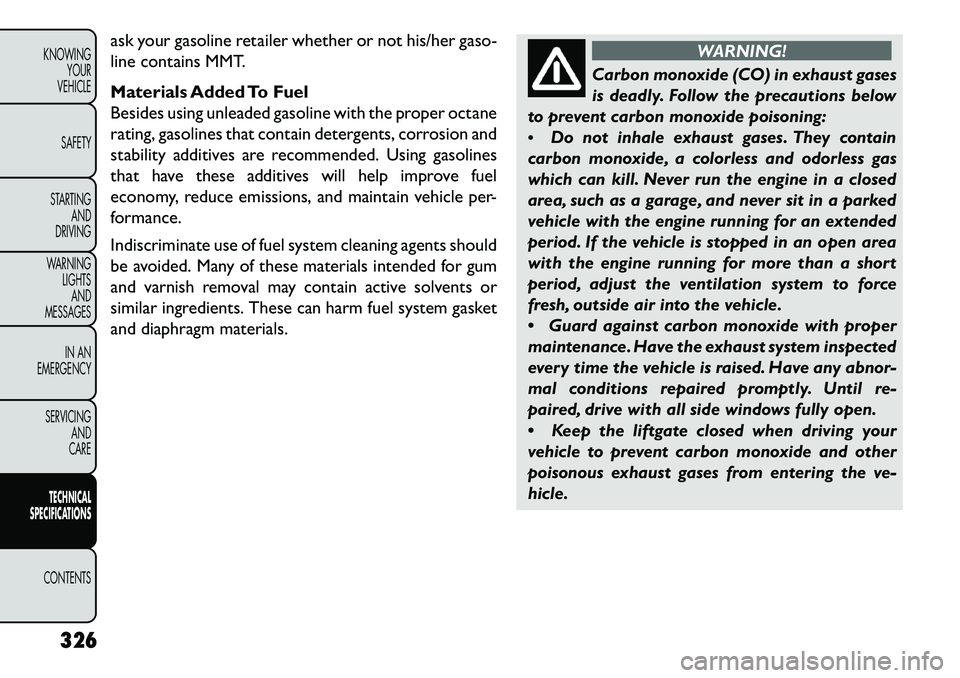
ask your gasoline retailer whether or not his/her gaso-
line contains MMT.
Materials Added To Fuel
Besides using unleaded gasoline with the proper octane
rating, gasolines that contain detergents, corrosion and
stability additives are recommended. Using gasolines
that have these additives will help improve fuel
economy, reduce emissions, and maintain vehicle per-
formance.
Indiscriminate use of fuel system cleaning agents should
be avoided. Many of these materials intended for gum
and varnish removal may contain active solvents or
similar ingredients. These can harm fuel system gasket
and diaphragm materials.
WARNING!
Carbon monoxide (CO) in exhaust gases
is
deadly. Follow the precautions below
to prevent carbon monoxide poisoning:
Do not inhale exhaust gases. They contain
carbon monoxide, a colorless and odorless gas
which can kill. Never run the engine in a closed
area, such as a garage, and never sit in a parked
vehicle with the engine running for an extended
period. If the vehicle is stopped in an open area
with the engine running for more than a short
period, adjust the ventilation system to force
fresh, outside air into the vehicle.
Guard against carbon monoxide with proper
maintenance. Have the exhaust system inspected
every time the vehicle is raised. Have any abnor-
mal conditions repaired promptly. Until re-
paired, drive with all side windows fully open.
Keep the liftgate closed when driving your
vehicle to prevent carbon monoxide and other
poisonous exhaust gases from entering the ve-
hicle.
326
KNOWING YOUR
VEHICLE
SAFETY
STARTING AND
DRIVING
WARNING LIGHTSAND
MESSAGES
IN AN
EMERGENCY
SERVICING AND
CARETECHNICAL
SPECIFICATIONSCONTENTS
Page 333 of 352
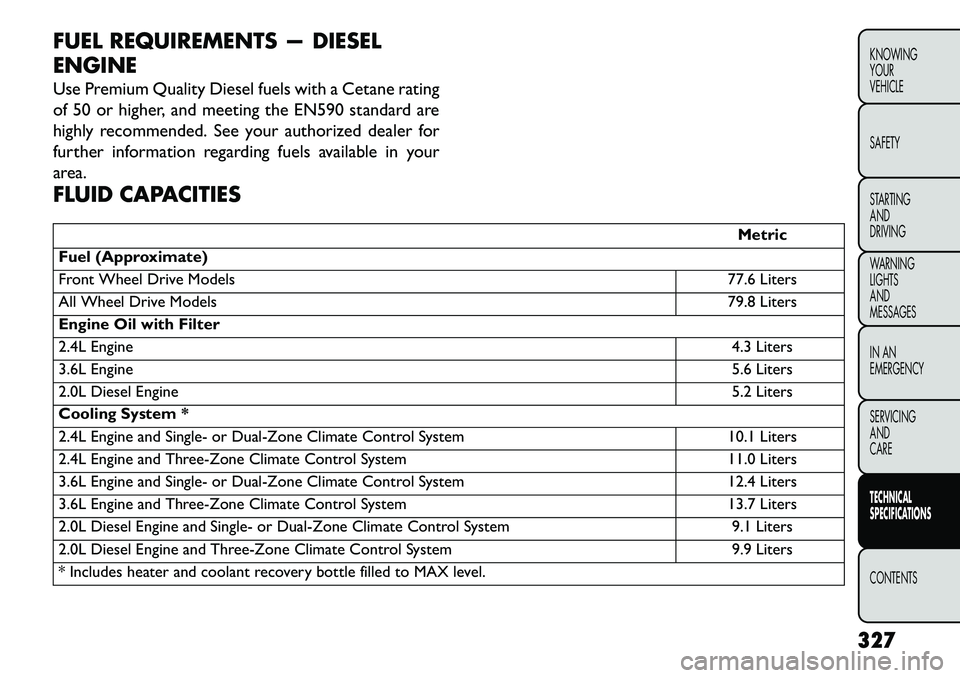
FUEL REQUIREMENTS — DIESEL
ENGINE
Use Premium Quality Diesel fuels with a Cetane rating
of 50 or higher, and meeting the EN590 standard are
highly recommended. See your authorized dealer for
further information regarding fuels available in your
area.
FLUID CAPACITIES
Metric
Fuel (Approximate)
Front Wheel Drive Models 77.6 Liters
All Wheel Drive Models 79.8 Liters
Engine Oil with Filter
2.4L Engine 4.3 Liters
3.6L Engine 5.6 Liters
2.0L Diesel Engine 5.2 Liters
Cooling System *
2.4L Engine and Single- or Dual-Zone Climate Control System 10.1 Liters
2.4L Engine and Three-Zone Climate Control System 11.0 Liters
3.6L Engine and Single- or Dual-Zone Climate Control System 12.4 Liters
3.6L Engine and Three-Zone Climate Control System 13.7 Liters
2.0L Diesel Engine and Single- or Dual-Zone Climate Control System 9.1 Liters
2.0L Diesel Engine and Three-Zone Climate Control System 9.9 Liters
* Includes heater and coolant recovery bottle filled to MAX level.
327
KNOWING
YOUR
VEHICLE
SAFETY
STARTING
AND
DRIVING
WARNING
LIGHTS
AND
MESSAGES
IN AN
EMERGENCY
SERVICING
AND
CARETECHNICAL
SPECIFICATIONSCONTENTS
Page 334 of 352
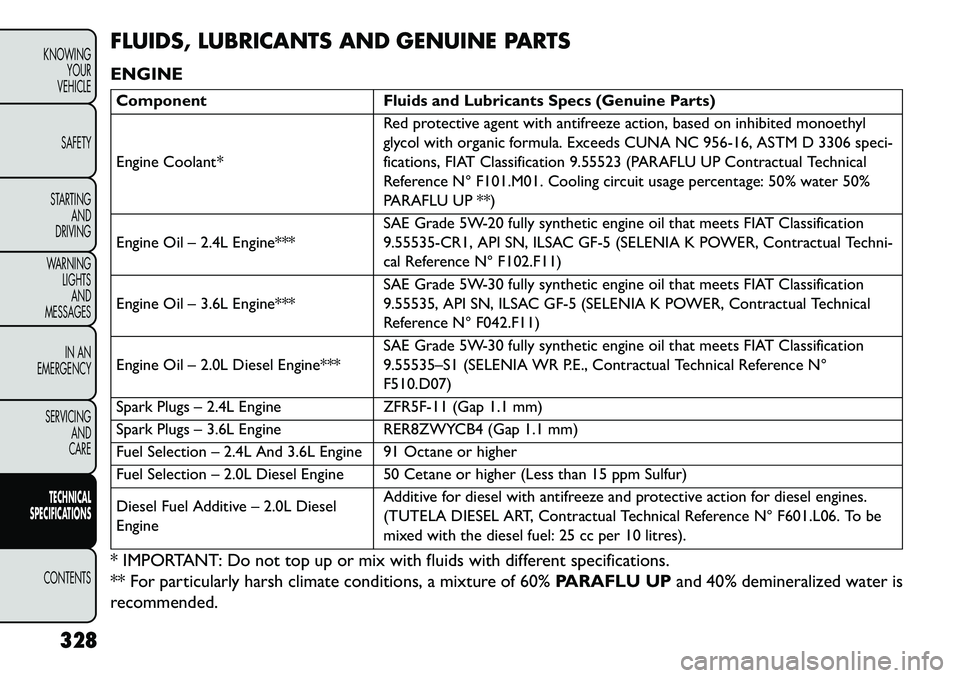
FLUIDS, LUBRICANTS AND GENUINE PARTS
ENGINEComponentFluids and Lubricants Specs (Genuine Parts)
Engine Coolant* Red protective agent with antifreeze action, based on inhibited monoethyl
glycol with organic formula. Exceeds CUNA NC 956-16, ASTM D 3306 speci-
fications, FIAT Classification 9.55523 (PARAFLU UP Contractual Technical
Reference N° F101.M01. Cooling circuit usage percentage: 50% water 50%
PARAFLU UP **)
Engine Oil – 2.4L Engine*** SAE Grade 5W-20 fully synthetic engine oil that meets FIAT Classification
9.55535-CR1, API SN, ILSAC GF-5 (SELENIA K POWER, Contractual Techni-
cal Reference N° F102.F11)
Engine Oil – 3.6L Engine*** SAE Grade 5W-30 fully synthetic engine oil that meets FIAT Classification
9.55535, API SN, ILSAC GF-5 (SELENIA K POWER, Contractual Technical
Reference N° F042.F11)
Engine Oil – 2.0L Diesel Engine*** SAE Grade 5W-30 fully synthetic engine oil that meets FIAT Classification
9.55535–S1 (SELENIA WR P.E., Contractual Technical Reference N°
F510.D07)
Spark Plugs – 2.4L Engine ZFR5F-11 (Gap 1.1 mm)
Spark Plugs – 3.6L Engine RER8ZWYCB4 (Gap 1.1 mm)
Fuel Selection – 2.4L And 3.6L Engine 91 Octane or higher
Fuel Selection – 2.0L Diesel Engine 50 Cetane or higher (Less than 15 ppm Sulfur)
Diesel Fuel Additive – 2.0L Diesel
Engine Additive for diesel with antifreeze and protective action for diesel engines.
(TUTELA DIESEL ART, Contractual Technical Reference N° F601.L06. To be
mixed with the diesel fuel: 25 cc per 10 litres).
* IMPORTANT: Do not top up or mix with fluids with different specifications.
** For particularly harsh climate conditions, a mixture of 60% PARAFLU UPand 40% demineralized water is
recommended.
328
KNOWING YOUR
VEHICLE
SAFETY
STARTING AND
DRIVING
WARNING LIGHTSAND
MESSAGES
IN AN
EMERGENCY
SERVICING AND
CARETECHNICAL
SPECIFICATIONSCONTENTS
Page 335 of 352

*** Lubricants with ACEA C2 performance as a minimum may be used for Diesel engines in an emergency, where
no original products are available. In such event, the engine may not provide optimal performance. We
recommend having the lubricant replaced as soon as possible. Using products with specifications lower than
ILSAC GF-5 for gasoline engines or lower than ACEA C2 for Diesel engines may cause engine damage not
covered by warranty.
CHASSISComponentFluids and Lubricants Specs (Genuine Parts)
Automatic Transmission (for
versions/markets, where provided) Totally synthetic lubricant that meets FIAT Classification 9.55550-AV4 (TU-
TELA TRANSMISSION FORCE4, Contractual Technical Reference N°
F108.F11)
Manual Transmission (for versions/
markets, where provided) Grade SAE 75W synthetic lubricant that meets FIAT Classification 9.55550-
MZ6 (TUTELA TRANSMISSION GEARFORCE Contractual Technical Refer-
ence N° F002.F10)
Brake/Clutch Master Cylinder Synthetic fluid that meets FIAT Classification 9.55597, FMVSS n° 116, DOT 4,
ISO 4925, SAE J-1704 (TUTELA TOP 4, Contractual Technical Reference N°
F001.A93)
Power Steering Reservoir Totally synthetic lubricant that meets FIAT Classification 9.55550-AV4 (TU-
TELA TRANSMISSION FORCE4, Contractual Technical Reference N°
F108.F11)
Windshield/Rear Window Washer
Fluid Mixture of alcohol, water and surfactants that meets FIAT Classification
9.55522, CUNA NC 956-11 (TUTELA PROFESSIONAL SC35, Contractual
Technical Reference N° F201.D02)
329
KNOWING
YOUR
VEHICLE
SAFETY
STARTING
AND
DRIVING
WARNING
LIGHTS
AND
MESSAGES
IN AN
EMERGENCY
SERVICING
AND
CARETECHNICAL
SPECIFICATIONSCONTENTS
Page 339 of 352
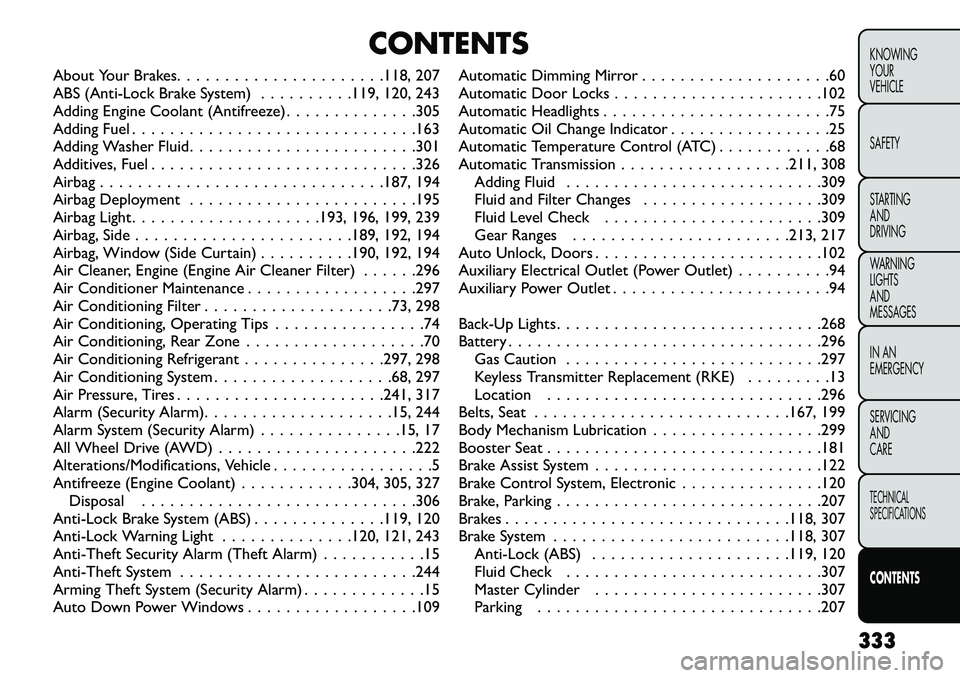
CONTENTS
About Your Brakes. . . . . . . . . . . . . . . . . . . . . .118, 207
ABS (Anti-Lock Brake System) . . . . . . . . . .119, 120, 243
Adding Engine Coolant (Antifreeze) . . . . . . . . . . . . . .305
Adding Fuel . . . . . . . . . . . . . . . . . . . . . . . . . . . . . .163
Adding Washer Fluid . . . . . . . . . . . . . . . . . . . . . . . .301
Additives, Fuel . . . . . . . . . . . . . . . . . . . . . . . . . . . .326
Airbag . . . . . . . . . . . . . . . . . . . . . . . . . . . . . .187, 194
Airbag Deployment . . . . . . . . . . . . . . . . . . . . . . . .195
Airbag Light. . . . . . . . . . . . . . . . . . . .193, 196, 199, 239
Airbag, Side . . . . . . . . . . . . . . . . . . . . . . .189, 192, 194
Airbag, Window (Side Curtain) . . . . . . . . . .190, 192, 194
Air Cleaner, Engine (Engine Air Cleaner Filter) . . . . . .296
Air Conditioner Maintenance . . . . . . . . . . . . . . . . . .297
Air Conditioning Filter . . . . . . . . . . . . . . . . . . . .73, 298
Air Conditioning, Operating Tips . . . . . . . . . . . . . . . .74
Air Conditioning, Rear Zone . . . . . . . . . . . . . . . . . . .70
Air Conditioning Refrigerant . . . . . . . . . . . . . . .297, 298
Air Conditioning System . . . . . . . . . . . . . . . . . . .68, 297
Air Pressure, Tires . . . . . . . . . . . . . . . . . . . . . .241, 317
Alarm (Security Alarm). . . . . . . . . . . . . . . . . . . .15, 244
Alarm System (Security Alarm) . . . . . . . . . . . . . . .15, 17
All Wheel Drive (AWD) . . . . . . . . . . . . . . . . . . . . .222
Alterations/Modifications, Vehicle . . . . . . . . . . . . . . . . .5
Antifreeze (Engine Coolant) . . . . . . . . . . . .304, 305, 327 Disposal . . . . . . . . . . . . . . . . . . . . . . . . . . . . .306
Anti-Lock Brake System (ABS) . . . . . . . . . . . . . .119, 120
Anti-Lock Warning Light . . . . . . . . . . . . . .120, 121, 243
Anti-Theft Security Alarm (Theft Alarm) . . . . . . . . . . .15
Anti-Theft System . . . . . . . . . . . . . . . . . . . . . . . . .244
Arming Theft System (Security Alarm) . . . . . . . . . . . . .15
Auto Down Power Windows . . . . . . . . . . . . . . . . . .109 Automatic Dimming Mirror . . . . . . . . . . . . . . . . . . . .60
Automatic Door Locks . . . . . . . . . . . . . . . . . . . . . .102
Automatic Headlights . . . . . . . . . . . . . . . . . . . . . . . .75
Automatic Oil Change Indicator . . . . . . . . . . . . . . . . .25
Automatic Temperature Control (ATC) . . . . . . . . . . . .68
Automatic Transmission . . . . . . . . . . . . . . . . . .211, 308
Adding Fluid . . . . . . . . . . . . . . . . . . . . . . . . . . .309
Fluid and Filter Changes . . . . . . . . . . . . . . . . . . .309
Fluid Level Check . . . . . . . . . . . . . . . . . . . . . . .309
Gear Ranges . . . . . . . . . . . . . . . . . . . . . . .213, 217
Auto Unlock, Doors . . . . . . . . . . . . . . . . . . . . . . . .102
Auxiliary Electrical Outlet (Power Outlet) . . . . . . . . . .94
Auxiliary Power Outlet . . . . . . . . . . . . . . . . . . . . . . .94
Back-Up Lights. . . . . . . . . . . . . . . . . . . . . . . . . . . .268
Battery . . . . . . . . . . . . . . . . . . . . . . . . . . . . . . . . .296 Gas Caution . . . . . . . . . . . . . . . . . . . . . . . . . . .297
Keyless Transmitter Replacement (RKE) . . . . . . . . .13
Location . . . . . . . . . . . . . . . . . . . . . . . . . . . . .296
Belts, Seat . . . . . . . . . . . . . . . . . . . . . . . . . . .167, 199
Body Mechanism Lubrication . . . . . . . . . . . . . . . . . .299
Booster Seat . . . . . . . . . . . . . . . . . . . . . . . . . . . . .181
Brake Assist System . . . . . . . . . . . . . . . . . . . . . . . .122
Brake Control System, Electronic . . . . . . . . . . . . . . .120
Brake, Parking . . . . . . . . . . . . . . . . . . . . . . . . . . . .207
Brakes . . . . . . . . . . . . . . . . . . . . . . . . . . . . . .118, 307
Brake System . . . . . . . . . . . . . . . . . . . . . . . . .118, 307
Anti-Lock (ABS) . . . . . . . . . . . . . . . . . . . . .119, 120
Fluid Check . . . . . . . . . . . . . . . . . . . . . . . . . . .307
Master Cylinder . . . . . . . . . . . . . . . . . . . . . . . .307
Parking . . . . . . . . . . . . . . . . . . . . . . . . . . . . . .207
333
KNOWING
YOUR
VEHICLE
SAFETY
STARTING
AND
DRIVING
WARNING
LIGHTS
AND
MESSAGES
IN AN
EMERGENCY
SERVICING
AND
CARETECHNICAL
SPECIFICATIONSCONTENTS